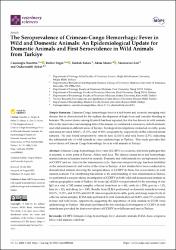The Seroprevalence of Crimean-Congo Hemorrhagic Fever in Wild and Domestic Animals: An Epidemiological Update for Domestic Animals and First Seroevidence in Wild Animals from Turkiye

View/
Date
2022Author
Çanakoğlu, NurettinBerber, Engin
Tonbak, şükrü
Aktaş, Münir
Vatansever, Zati
Özdarendeli, Aykut
Metadata
Show full item recordCitation
Nurettin, C.; Engin, B.; Sukru, T.; Munir, A.; Zati, V.; Aykut, O. The Seroprevalence of Crimean-Congo Hemorrhagic Fever in Wild and Domestic Animals: An Epidemiological Update for Domestic Animals and First Seroevidence in Wild Animals from Turkiye. Vet. Sci. 2022, 9, 462. https://doi.org/10.3390/vetsci9090462Abstract
Crimean-Congo hemorrhagic fever virus (CCHFV) is a zoonotic, tick-borne pathogen that is endemic to some parts of Europe, Africa, and Asia. The disease causes fever and hemorrhagic manifestations in humans but not in animals. Domestic and wild animals are asymptomatic hosts of CCHFV and are critical in the transmission cycle. Hyalomma marginatum spp. has been identified as the natural reservoir and vector of the virus in Turkiye. A few studies have been conducted on domesticated animals showing the seroprevalence of CCHFV in them, but seroevidence in wild animals is absent. For contributing this antrum to the understanding of virus transmission in Turkiye, we performed a seroprevalence investigation of CCHFV in both wild and domesticated animals in various geographical areas of Turkiye. In-house IgG iELISA was performed for the screening of sera IgG in a total of 582 animal samples collected from boar (n = 40), cattle (n = 259), goat (n = 132), hare (n = 21), and sheep (n = 130). Results from ELISA performed on domestic animals revealed 10.81%, 15.15%, and 19.23% anti-CCHF virus seropositivity in cattle, goats, and sheep, respectively, in collected serum samples. ELISA tests performed in wild animals showed 23.81% and 2.5% positivity in hare and wild boars, respectively, suggesting the importance of wild animals in CCHF virus epidemiology in Turkiye. This study performed the first serological investigation of CCHFV in wild animals and provided the first seroevidence of CCHFV in wild boars and hare in Turkiye.

















